中文 特展详细网页
Highlights of the Exhibition
Chapter 1: Cao Cao, Liu Bei and Sun Quan–Tracing the Roots of the Three Great Leaders
Chapter 2: The Han Dynasty–Shadow and Light
Chapter 3: Wei, Shu and Wu–A Tripartite Battle for Supremacy
Chapter 4: A Journey Through the Three Kingdoms
Chapter 5: The Cao Cao Mausoleum and Other Grand Tombs from the Three Kingdoms Period
Epilogue: The End of the Three Kingdoms Period and the Rise of a New Power
Prologue: Legends of the Three Kingdoms Period
The Three Kingdoms period began around 1,800 years ago amid the chaos of the Eastern Han dynasty (25–220). The events of this time and tales about the rise and fall of the era’s various warlords were written down for prosperity. These records later became beloved historically-based legends. These in turn provided the inspiration for numerous works of poetry, literature and painting, with military commanders like Guan Yu even deified by later generations. All this led to the formation of a rich and colorful “Three Kingdoms culture” that still resonates to this day.
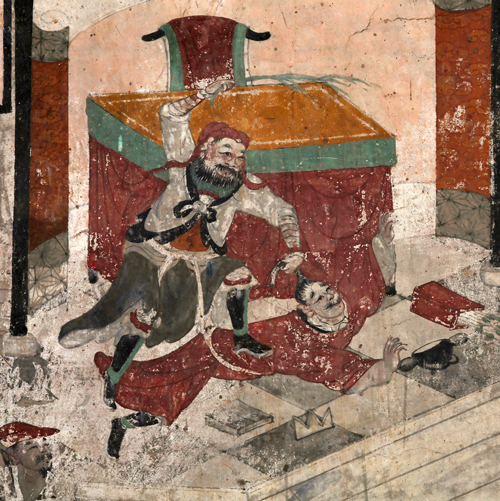 
Guandi Temple Murals(detail)
Qing dynasty, 18th century, Passed down by Fulong Temple, Shuimenta, Qingshuihe Country, Hohhot City, Inner Mongolia, Autonomous Region (Inner Mongolia Museum)
|
|
 
Zhao Yun
Qing dynasty, 17th–18th century, Passed down by Huaxi Building, Bozhou City, Anhui (Bozhou Museum)
|
Page Top
Chapter 1: Cao Cao, Liu Bei and Sun Quan–Tracing the Roots of the Three Great Leaders
Cao Cao founded the state of Wei. Using a power base inherited from his ancestors, he wielded influence at the heart of the Han dynasty court. This enabled him to achieve supremacy during turbulent times. Liu Bei founded the state of Shu. He claimed to be related to the Han imperial family and he fought to revive the Han dynasty’s fortunes. Sun Quan founded the state of Wu. He forged his own unique path to power by developing a strong naval network. These three men were lionized by later generations. This chapter uses specially-selected cultural artifacts to trace their roots.
 
Leopard
Western Han dynasty, 2nd century BC, Excavated at the tomb of Prince Liu Sheng of Zhongshan and his wife, Baoding City, Hebei, 1968 (Chinese First Grade Cultural Relic, Hebei Museum)
|
|
 
Cargo and Passenger Boat
Eastern Han dynasty–Three Kingdoms period (Wu), 3rd century, Excavated at Tomb No. 14, Liangjuntong, Guigang City, Guangxi Autonomous, Region, 2010 (Guangxi Institute of Cultural Relics and Archaeology)
|
Page Top
Chapter 2: The Han Dynasty–Shadow and Light
The Han dynasty became one of the largest Chinese empires, with a rule that extended across much of present-day China. However, the imperial court was rocked by internal political strife at the end of the 2nd century, with the reach of the emperor waning. Chaos reigned throughout society. The Yellow Turban Rebellion occurred when groups with beliefs that later developed into Daoism arose in the regions and tried to overthrow the old order, while the warlord Dong Zhuo launched a reign of tyranny in the Han capital Luoyang.
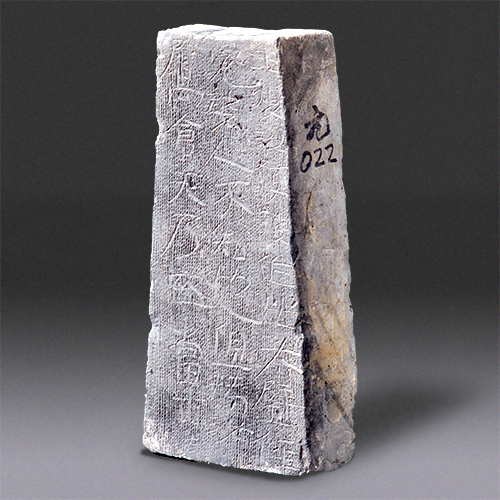 
Brick with Chinese Characters “Cang Tian” (Blue sky)
Eastern Han dynasty, 2nd century, Excavated at Tomb No. 1, Yuanbaokeng, Bozhou City, Anhui, 1976–1977 (National Museum of China)
|
|
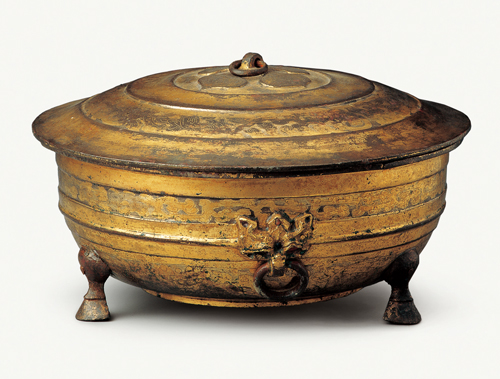 
Wine Cask
Eastern Han dynasty, 2nd–3rd century, Excavated at Leitai Tomb, Wuwei City, Gansu, 1969 (Chinese First Grade Cultural Relic, Gansu Provincial Museum)
|
Page Top
Chapter 3: Wei, Shu and Wu–A Tripartite Battle for Supremacy
The states of Wei, Shu and Wu were formed at the end of the Eastern Han dynasty. They became locked in a tripartite struggle, with fighting particularly fierce at their respective borders. After Cao Cao passed away in 220, he was succeeded by his son Cao Pi (Wen Di). Cao Pi then seized the throne from the Eastern Han emperor. This move was met with resistance from Liu Bei in Shu and Sun Quan in Wu, with each warlord claiming legitimacy and announcing the founding of their own states. This chapter traces this tumultuous transition to a new era through weapons from the Eastern Han dynasty and Three Kingdoms periods together with cultural artifacts related to famous battles.
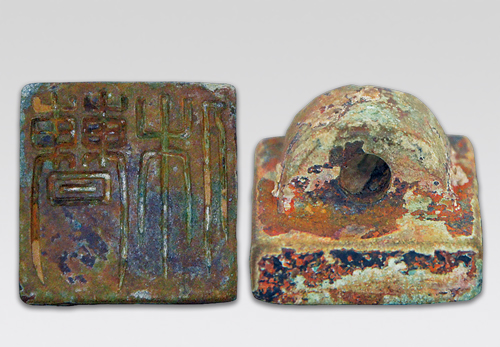 
Seal with Chinese Characters “Cao Xiu”
Three Kingdoms period (Wei), 3rd century, Excavated at the Tomb of Cao Xiu, Luoyang City, Henan, 2009 (Luoyang City Cultural Relics and Archaeology Research Institute)
|
|
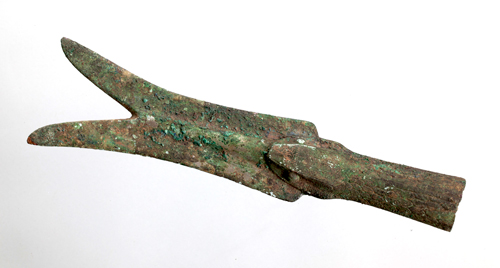 
She Mao (snake spear)
Shizhaishan culture, 2nd century BC, Excavated at Tomb No. 3, Mount Shizhai, Kunming City, Yunnan, 1956 (Yunnan Provincial Museum)
|
Page Top
Chapter 4: A Journey Through the Three Kingdoms
The state of Wei held sway in the Yellow River basin, the geographical center of the Han dynasty. The state of Shu controlled the plain upstream of the Yangtze River, an area of rich natural beauty, while the state of Wu’s stronghold was located in the plains and coastal areas mid and downstream of the Yangtze. These different climates gave rise to distinctive cultures and customs. This chapter explores the unique characteristics of the three states through artifacts excavated from these areas.
 
Mirror with a square and TLV Patterns, and Bird Motifs
Eastern Han dynasty–Three Kingdoms period (Wei), 2nd–3rd century, Excavated at Tomb No. 1, Sandaohao, Liaoyang City, Liaoning, 1955 (Liaoning Provincial Museum)
|
|
 
Funerary Jar
Three Kingdoms period (Wu), dated 272, Excavated at Tomb Shangfang, Jiangning District, Nanjing City, Jiangsu, 1993 (Chinese First Grade Cultural Relic, Nanjing Museum Administration)
|
Page Top
Chapter 5: The Cao Cao Mausoleum and Other Grand Tombs from the Three Kingdoms Period
The transition from the end of the Eastern Han dynasty to the Three Kingdoms period in the early 3rd century also saw the emergence of a new approach to tomb building. Tombs became less ostentatious as rulers began to place more value on simplicity and frugality. The philosophies and social values of these rulers are on full display in eminent ancient tombs scattered across each region, including the Cao Cao Mausoleum, which was excavated in 2008–2009.
 
Guan Jar
Eastern Han dynasty–Three Kingdoms period (Wei), 3rd century, Excavated at the Cao Cao Mausoleum, Anyang City, Henan, 2008–2009 (Chinese First Grade Cultural Relic, Henan Provincial Institute of Cultural Heritage and Archaeology)
|
|
 
Gold Metal Belt Fitting with Animal Design
Eastern Han dynasty, 2nd century, Excavated at Shouchun Ancient Tomb, Shou County, Huainan City, Anhui, 2009 (Chinese First Grade Cultural Relic, Shou County Museum)
|
Page Top
Epilogue: The End of the Three Kingdoms Period and the Rise of a New Power
After many long years of fighting, control of China ultimately eluded the forces of Wei, Shu and Wu. Instead, a powerful Wei general called Sima Yi rose to prominence, with his grandson Sima Yan going on to establish the Western Jin dynasty (265–420). The Sima administration established a new order in China while protecting the base of the powerful clans in each region.
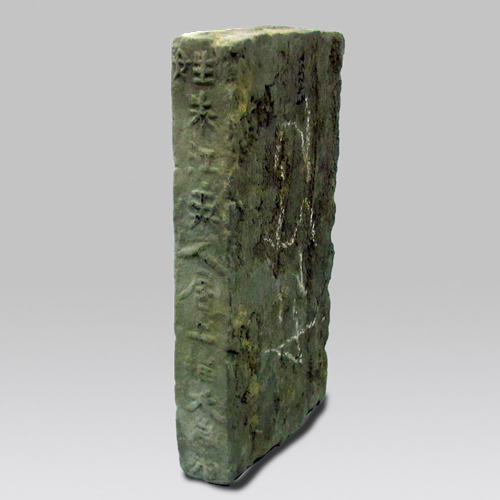 
Brick with Inscription Reading “Jinping Wu Tianxia Taiping”
Western Jin dynasty, dated 280, Excavated at Tomb No. 1, Suoshu Brick Factory Site, Nanjing City, Jiangsu, 1985 (Nanjing Museum Administration)
|
|
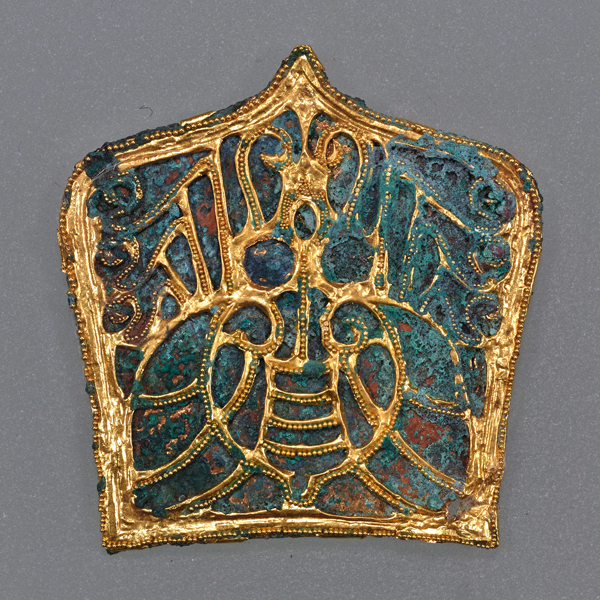 
Crown Decoration with Cicada Design
Western Jin dynasty, 3rd century, Excavated at Tomb No. 1, Inkstone Pool at Former Residence of Wang Xizhi, Linyi City, Shandong, 2003 (Linyi Museum)
|
Page Top
![]() PDF 134KB)
PDF 134KB)














